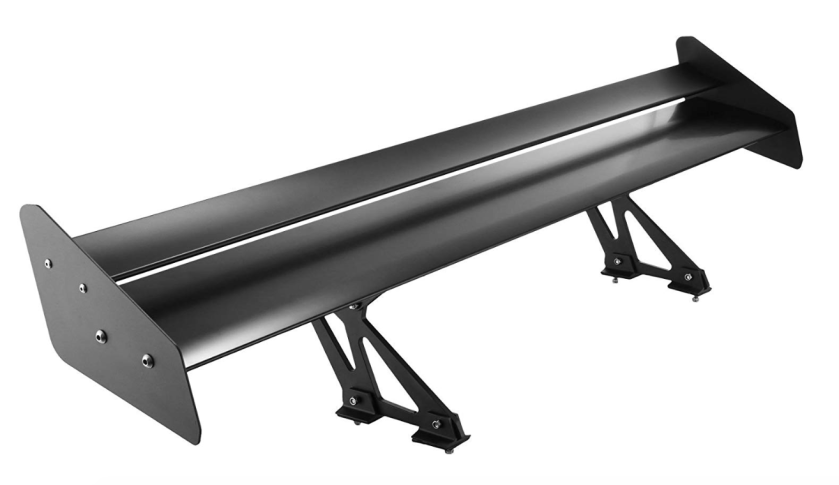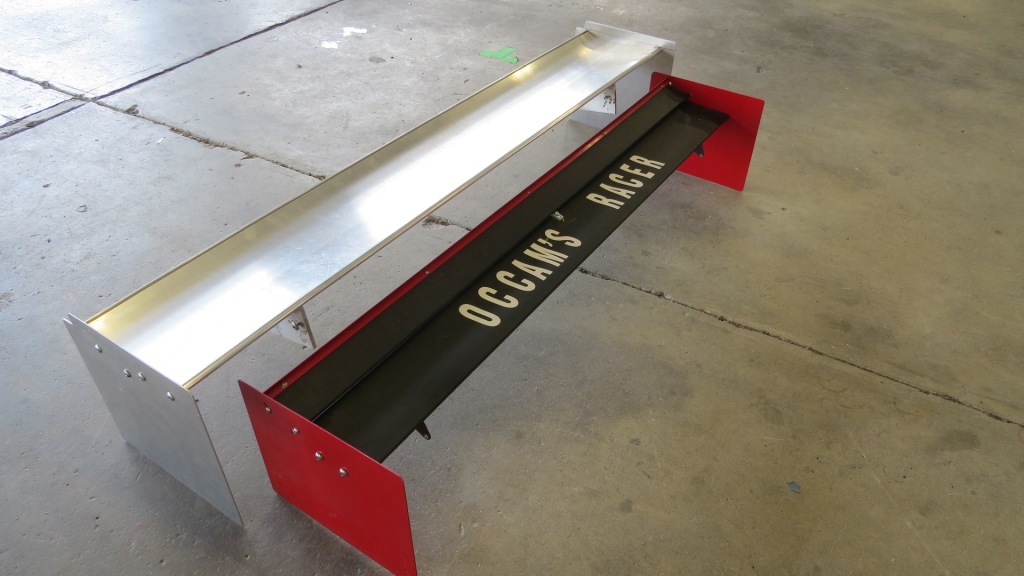The price and availability of aerodynamic car wings are making them more common in crap-can endurance racing. You can buy a cheap extruded aluminum wing on eBay, Amazon, or other online retailers for $50, but are they good for anything?

I broke the piggy bank and purchased a 53” double-decker wing for $75, shipped. This wing is sold under a variety of brand names like BestEquip, Mophorn, Neverland, etc, and I’ll refer to this as the eBay wing, because that’s where I got it.
Immediately upon unboxing, I knew I’d have to make some modifications. Like most budget items from China, it came with trunk mounts too low to allow airflow to go under the wing. I trusted the supplied mystery-metal hardware as far as I could throw them, which was directly in the trash.
The main wing felt light, yet surprisingly rigid. The stiffness is partly from the dual horizontal mounting rails, which allow the wing to be mounted at just about any width. However, the exposed slots and flat underside of the wing can’t be great for keeping airflow attached. In the future, I may add some curvature here.
The upper wing felt like a noodle, and I feared it would vibrate and hit the lower wing at speed. So I riveted on a Gurney flap of 1/4” aluminum angle to stiffen it up. I also added a small stop in the middle of the lower wing to limit downward movement of the upper wing.
The end plates had to go, not only because they were too small, but they didn’t allow the upper wing to pivot into the correct position. According to McBeath in Competition Car Aerodynamics, the upper wing should overlap the lower wing at about 4% of the chord (.3” in this case). In order to accelerate the air, the gap must be larger at the front than at the rear. With those two factors set, the slots in the supplied end plates, which support and locate the upper wing, wouldn’t allow us to pivot the upper wing into a useful angle.
Since I couldn’t get the correct spacing and wing angle with the supplied end plates, I made my own from 12”x10” sheet metal, and drilled new upper wing mounting slots. All done I paid a little over $110 for the wing and modifications, and a couple hours figuring all that out.
The car was set up with -1 degree of negative rake, meaning the back was lower than the front. Ideally it should be the other way around, but we got lost debugging what we thought was a clearance issue with a front sensor and didn’t correct the angle.
I set the lower wing angle to 3 degrees, but because of the chassis rake, the main wing was closer to 2.5 degrees. I set the upper wing to 12 degrees. Measured over the entire chord, this created a total camber of about 14 degrees, which is right in the middle of the values that McBeath cites in Competition Car Aerodynamics. Given more time, I would have experimented with the angle of attack of the upper element, as well as the entire wing. However, not knowing how the wing would perform, I chose middle-of-the-road values from a published text, and figured it was more important to avoid a stall condition than maximize downforce. The wing weighed 7.6 pounds altogether, which is very light.

The wing I used through all the other testing on this site is a 60” 9 Lives Racing “Big Wang”. When I took it out of the package I was immediately impressed by the sturdy construction. When there are only cockroaches left in the world, there will also be 9LR wings. I made my own 12” x 12” end plates and mounting brackets, and had a local shop weld the mounts underneath. The entire setup was about $500, and weighed in at 14.4 pounds.
I set the wing angle at 5 degrees, but with chassis rake the actual wing angle measured 4.6 degrees. If you look at the 9 Lives CFD open air data, this is right in the middle of the wing’s working range. I knew the downwash angle would change with every top, and that this would change the effective wing angle. But due to intermittent track closures, I didn’t get a chance to optimize the wing angle, and left it where it was.
For both wings I used the same wing stands, which I cut from ¼” aluminum plate. Many racing series limit wings to roof height, so I made sure the highest part of the wing was level with the roof. I bolted the base of the wing stands through the sides of the trunk gutter, and while this seemed strong enough, I added another L-bracket on top of the rear fenders, and this stiffened things up considerably.
Wings compared
So let’s see how these wings compared. In this first chart, we’re looking at front and rear downforce using GPS speed alone. It looks like the eBay wing (red) creates more rear downforce as the 9 Lives Racing wing (blue), and when combined with the front, the total downforce is pretty close.
However, the weather had changed during this run, and we had an 11 mph headwind. After correcting the wind speed detected by the pitot tube, a clearer picture developed. See the bar graph below. Here we can see that the eBay wing generated less downforce than the GPS speed would have us believe. This is why you can’t trust testing using GPS speed alone, and why you hire a guy like Jeremiah.
When you add downforce on one end of the car, you can expect to lose downforce on the other end. This is the natural see-saw effect of pushing down on one end. What’s interesting here is that the 9 Lives Racing wing not only made more rear downforce, but it also had more front downforce. How can this be?
The most likely reason is drag. The eBay wing creates more drag, and this rear-biased force lifts the front end. Another possibility is that the wing interacts with airflow under the car, and somehow the eBay wing is reducing the effectiveness of the splitter. That’s less likely, but whatever the case, front downforce, and thus total downforce, is a lot less with the eBay wing.
Take a look at the following table and you can see the corresponding values for coefficient of lift (which we’ve been familiarizing as “downforce”), and drag. We already saw that the 9 Lives Racing wing practically doubled the total downforce, and here you can see it did that while creating 15% less drag. If you look at the final column in the table, you’ll see that the drag reduction alone equals an extra 8 hp at 100 mph.
| Wing | Front Coeff Lift | Rear Coeff Lift | Total Coeff Lift | Coeff Drag | L/D Ratio | Front Aero Load Dist. % | HP @ 100mph |
| 9LR | -0.17 | -0.84 | -1.01 | 0.48 | 2.11 | 16.76% | 52.78 |
| eBay | 0.03 | -0.58 | -0.56 | 0.55 | 0.90 | 4.43% | 60.79 |
If we divide the total coefficient of lift by the coefficient of drag, you get the L/D ratio, which tells you how efficient the entire aero package is. Here you can see the 9 Lives Racing wing contributes to a setup that is over 230% more efficient at creating downforce.
The data from testing other tops shows that the 9LR wing changes the coefficient of drag by about .03 across all tops, from open top to fastback. By contrast, the double wing changes the Cd by .10. Yowza, that’s a lot.
One final calculation is the front aero load distribution percentage, which gives you an idea of how much the car will understeer (a low percentage) or oversteer (a high percentage). The low values here indicate that with either wing, the car would understeer badly. This is partially due to the negative rake of the chassis and negative splitter angle (both setup mistakes that should have been corrected before testing). However, even with these setup details corrected, the eBay wing would produce a car that understeers more.
As usual, let’s see what happens in OptimumLap. To spice things up, I’ll also add the data from the 9LR wing with an open top.
| 9LR vs eBay | Watkins Glen | Waterford Hills | 2010 SCCA Nationals |
| Hard top, 9LR | 2:22.96 | 1:19.95 | 1:03.34 |
| Hard top, eBay | 2:25.71 | 1:20.99 | 1:03.81 |
| Open top, 9LR | 2:24.02 | 1:20.97 | 1:03.88 |
The 9 Lives Big Wang outperforms the cheap eBay wing in every way. In fact, the 9LR wing with an open top out performs the eBay wing with an OEM hard top on any track that isn’t autocross. 9 Lives Racing is a small, made-in-the-USA business with employees who race cars, and you can feel good about supporting them.
But if you’re racing in 24 Hours of Lemons on a $500 budget, you might find that a cheap wing suits your janky crap-can just fine. The wing could have performed better with more fine tuning, but it’s clearly a case of “you get what you pay for.” If you purchase this wing, you might want to take similar steps that I did to limit movement of the upper wing, optimize the convergent gap and wing angles, and get the wing about 6 feet above your roofline. It is Lemons, after all.